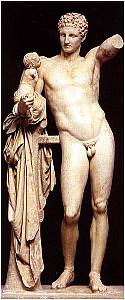| |
Transfer Athens
Athens-Epidavros
Monemvasia.
Olympia
Peloponnese-Tripolis
Kalamata
Mycenae & Nauplia
Athens-Daily Delphi Tour
Delphi & Meteora- 2 Days
Athens- Classical Tour to Argolis & Peloponnese Pr
|
 Olympia Olympia
Request this tour
At the foot of the Kronion Hill stretches the space formed by the wedge of land between the converging rivers of the Alfios and the Kladeos. This was the site called the Sacred Grove of the Altis, regarded as belonging to Zeus in which, in historically recorded times, the most famous of Greek sanctuaries was estabilshed.
Formerly it had been a place of worship of pre-Hellenic deities. Every four years, athletic contests were organized here in honour of Zeus, lasting seven days. According to legend, the Olympic Games began after a victory by Pelops against Oenomaos, King of Pissa.
Historically, the Olympic Games began in 776 B.C. Up to the 5th century B.C., the sacred enclosure contained the Heraion, the Prytaneion, the Pelopeion and the Hippodameion while, at the foot of the Kronion Hill, stood the twelve Greek city treasures.
Outside the enclosure to the West, was the Stadium with a 45,000 seating capacity (men only were allowed in). Access to the Stadium was along a vaulted passage and, to the South, was the Vouleutirion where the Olympic Senate met.
From the 5th century onwards, the sanctuary assumed its final form with the impressive temple of Zeus (peripteral in the Doric style) the Metroon, the Arcades (Stoa of Echo and the Southern Stoa), the Gymnasium and the Palaestra, the living quarters of the priests, the large Leonidaion Hostel and the Filippeion.
To the South of the dwellings of the priests, excavations revealed the studio of the sculptor Phideias in which he carved the gold and ivory statue of Zeus.
Finally, in Roman times, the villa of the Roman emperor Nero was added, also the Exedra of Herodes Atticus and Roman baths. The Olympic Games ceased in 393 A.D. after the edict issued by Theodosius the Great which forbade all pagan festivals. They were revived for the first time after fifteen centuries, in 1896 in the marble stadium in Athens.
Today, an international Olympic Academy functions at Olympia. There is also a Museum of Olympic Games (tel. (0624) 22 544) where data connected with the Olympic Games are displayed together with a Collection of commemorative postage stamps.
Archaeological Museum
The Museum at Olympia contains most interesting exhibits.
Among various other items, there is the most impressive collection of sculpture of the austere style (first half of the 5th century B.C.).
There are also the pediments and metopes of the temple of Zeus. The East pediment portrays preparations for the chariot race between Pelops and Oenomaos while the West pediment shows the battle between the Lapiths and the Centaurs.
The twelve metopes, three of which are Gypsum casts, depict the twelve Labours of Hercules. Two more masterpieces of 5th and 4th centuries. B.C. are to be seen in the originals of the sculptors Paionios with his statue of Niki (Victory) and of Hermes by Praxiteles. Of the terracotta sculptures, the most complete is a composition of Zeus and Gannymede (most probably from a temple pediment).
There is also a rich collection of bronze articles such as figurines and small effigies, tripods, strips, arms and portions of armour (helmets, breastplates, grieves, etc.). Among these is a Persian helmet from the booty captured by the Athenians, after the battle of Marathon and also the helmet worn by Miltiades, the victorious commander of the Athenian forces in that battle.
|